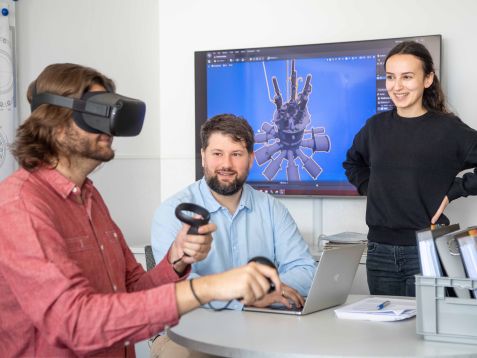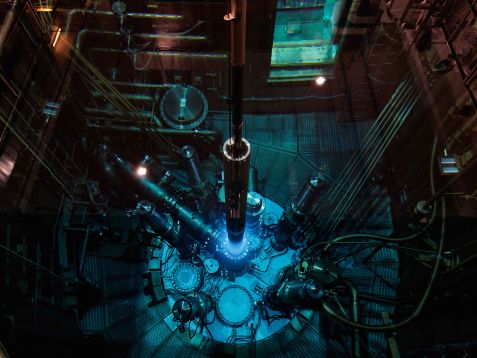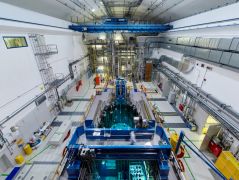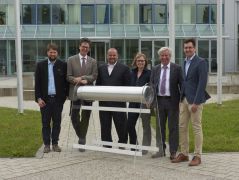MLZ is a cooperation between:
 > Technische Universität München
> Technische Universität München > Helmholtz-Zentrum Hereon
> Helmholtz-Zentrum Hereon
 > Forschungszentrum Jülich
> Forschungszentrum Jülich
MLZ is a member of:
 > LENS
> LENS > ERF-AISBL
> ERF-AISBL
MLZ on social media:

MLZ (eng)
Lichtenbergstr.1
85748 Garching
25.11.2022
Operation of FRM II possible with Low Enriched Uranium
Scientifically speaking it is possible to convert the Research Neutron Source (FRM II) at the Technical University of Munich (TUM) for a fuel element with Low Enriched Uranium (LEU). This conclusion is the result of TUM researchers’ calculations, which have been independently confirmed by experts in the USA. This establishes the theoretical foundations for implementing state regulatory requirements to discontinue the use of Highly Enriched Uranium (HEU) as fuel at the FRM II in the future.
For the first time, researchers at the Research Neutron Source Heinz Maier-Leibnitz (FRM II) have used highly complex computer simulations to identify an option for conversion which is to function using fuel elements whose fissionable uranium-235 has been enriched to less than 20 %. The proposed LEU fuel element meets safety requirements, is compatible with the current fuel element and can maintain the FRM II neutron flux necessary for research.
TUM President Prof. Thomas F. Hofmann emphasizes the enormous significance of the FRM II for science and innovation: “Researchers from all around the world come to Garching and use its neutrons in scientific investigations. These include for example analysis of energy storage materials and batteries as well as materials used in gas turbines. The FRM II even played a significant role in the development of the mRNA vaccine. I am very pleased that the theoretical calculations have been established for converting the FRM II for LEU fuel operations. This is the foundation for the continuing operation of the neutron source.”

Fuel element research at the FRM II (from left): Paul Weimer, Dr. Christian Reiter, Kaltrina Shehu. © Andreas Heddergott, TUM
Results using supercomputers and Deep Learning
In a complicated parameter study Dr. Christian Reiter, reactor physicist at the FRM II and head of the Theory Division at the TUM Center for Nuclear Safety and Innovation, worked with his group on the calculations linked with many possible changes to the FRM II fuel element. This involved the use of a separate computing cluster at the Leibniz Supercomputing Center (LRZ) and newly developed software with Deep Learning. The conclusion: An LEU fuel element for the FRM II is viable in terms of reactor physics and can be operated using the existing systems; no major conversion of the neutron source will be necessary. “Viewed as an average for all scientific instruments and over a 60-day operational cycle, the neutron flux from the proposed LEU fuel element will be no more than 10 % lower than with the current fuel element,” says Reiter.
The simulations by the TUM researchers have been independently confirmed by the Argonne National Laboratory (ANL) in den USA using different computer code. The ANL has been involved in conversion of research reactors worldwide since 1978. Reiter emphasizes the fact that as the prerequisite for the calculations in his study he assumes that the new fuel element will have to be capable of regulatory certification in Germany and that it will be possible to produce the new fuel elements with the proposed changes. The study makes no statements about the actual technical feasibility of fulfilling these conditions.
Basic legal parameters
An ancillary condition in the third partial certification of the FRM II provides for conversion to a “fuel with a maximum uranium-235 enrichment of 50 % […] as soon as the new fuel has been developed, qualified and is industrially available”. In 2020 the Bavarian and federal German ministries of science agreed to decide on the fuel element variant in 2023 based on the research results which will be available by then. The approval procedure for the new fuel is to be initiated by 2025. Scientific Director of FRM II, Prof. Peter Müller-Buschbaum, says: “We have shown that it is possible in terms of reactor physics to operate the FRM II with an LEU fuel element. The groundwork for the decision has now been completed.”
More information:
The calculations and simulations were conducted by researchers at the Technical University of Munich and the Argonne National Laboratory, USA. Research at TUM was financed by German Federal Ministry of Education and Research (BMBF) and the Bavarian State Ministry of Science and Art (StMWK).
Activities at the Argonne National Laboratory were financed by the US Department of Energy, the Office of Material Management and Minimization in the US National Nuclear Security Administration the Office of Defense Nuclear Nonproliferation.
- TUM Center for Nuclear Safety and Innovation
- Conversion of the Research Neutron Source Heinz Maier-Leibnitz
- 2020 agreement on converting the FRM II
Contact:
Dr. Christian Reiter
Head of the TUM Center for Nuclear Safety and Innovation
Research Neutron Source Heinz Maier-Leibnitz (FRM II)
Technical University of Munich (TUM)
E-Mail: christian.reiter@frm2.tum.de
Related News
-
06.05.2020
Pioneering work: Prototype of a new fuel
MLZ is a cooperation between:
 > Technische Universität München
> Technische Universität München > Helmholtz-Zentrum Hereon
> Helmholtz-Zentrum Hereon
 > Forschungszentrum Jülich
> Forschungszentrum Jülich
MLZ is a member of:
 > LENS
> LENS > ERF-AISBL
> ERF-AISBL
MLZ on social media:





